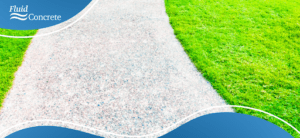Design Considerations and Planning for Making Exposed Aggregate Walkways

The Importance of Protecting and Maintaining Exposed Aggregate Around Pools
August 20, 2024
What Influences The Curing And Safety Of Exposed Aggregate Concrete?
October 25, 2024This is a method of laying concrete with an exposed top layer of decorative elements such as pebbles, granite, stones and more. The exposed top layer rests on a concrete base and adds aesthetic appeal. Not only does an exposed aggregate walkway look appealing, but it’s also a very durable and cost-effective option for homes, businesses and public areas. This article highlights things to consider when making exposed aggregate walkways.
Design configurations for exposed aggregate walkways
What specific considerations should be made when designing exposed aggregate walkways for public spaces?
Planning your walkway is vital for the success of the finished project. For a visually appealing layout, add some curves to the design rather than making the walkway all straight lines. When designing walkways for public spaces, you must have safety and accessibility in mind. Don’t leave the aggregate too exposed and rough on the surface, and make sure there is access for people with disabilities and the elderly.
Site assessment and preparation
What site conditions must be assessed before beginning an exposed aggregate walkway project?
A survey of the area needs to be conducted first before excavation and boxing takes place. Check the stability and drainage of the soil that the concrete will be poured onto. Unstable soil can result in cracking, and soil that’s too porous could absorb too much moisture from the concrete too soon.
First, excavate the pathway and then use a compactor to stabilise the bed. Once this is accomplished, you can start the boxing process and the mixing and pouring of concrete.
Creating and installing the walkway
Mixing and pouring concrete
Spend time ensuring the concrete mix has the right blend of ingredients. This guarantees durability and longevity. You also don’t want it to be too wet or too dry. Premixed concrete also works for exposed aggregate walkways. Once the concrete is mixed to perfection, pour it into the boxed-in section and screed the concrete. Now go over the surface with a trowel for a smooth finish.
Seeding and exposing the aggregate
Scatter the pebbles or your chosen decorative element onto the surface of the concrete by the handful. Wait for the concrete to be firm enough that the stones don’t sink below the surface.
Using a trowel, push the pebbles into the surface. Be careful to avoid denting the surface of the concrete with the edges of the trowel. Trowel the surface smooth. A thin slurry of cement will now be covering the pebbles.
Take a break and wait for the concrete to firm up. This could be anywhere up to 8 hours or more. You can test it by touching the concrete with your finger. If it doesn’t stick to your finger, but you can scratch the surface with your nail, you’re good to go to expose the aggregate.
Using a brush and a light spray of water, gently expose the pebbles by brushing and washing away the top layer of cement.
Ensuring accessibility
How can one ensure accessibility in exposed aggregate walkway installations?
When constructing your walkway, keep in mind the need for smooth transitions and adequate width for people with mobility aids. Creating non-slip surfaces is also a must. To ensure compliance with accessibility standards, consult with your local council for guidelines.
Customisation options
What customisation options are available for exposed aggregate walkways?
When creating your walkway, you can use different coloured stones or even create patterns and pictures with your chosen aggregate. Mixing in a variety of stones of different sizes, you’ll achieve a variety of textures and unique appearances.
Integration with other hardscape elements
How to integrate exposed aggregate walkways with other hardscape elements?
Exposed aggregate walkways can seamlessly be integrated with other hardscapes, such as running along the line of retaining walls constructed of brick or stone. Use exposed aggregate around pools, ponds, driveways and other features.
You can even combine your designs with brick and stone features to add a unique touch to exposed aggregate walkways.
Exposed aggregate services in Perth
At Fluid Concrete, we specialise in creating stunning and durable exposed aggregate walkways. No matter what outdoor area you want to liven up with exposed aggregate, we’re the team to call, so get in touch today to discuss your project.





